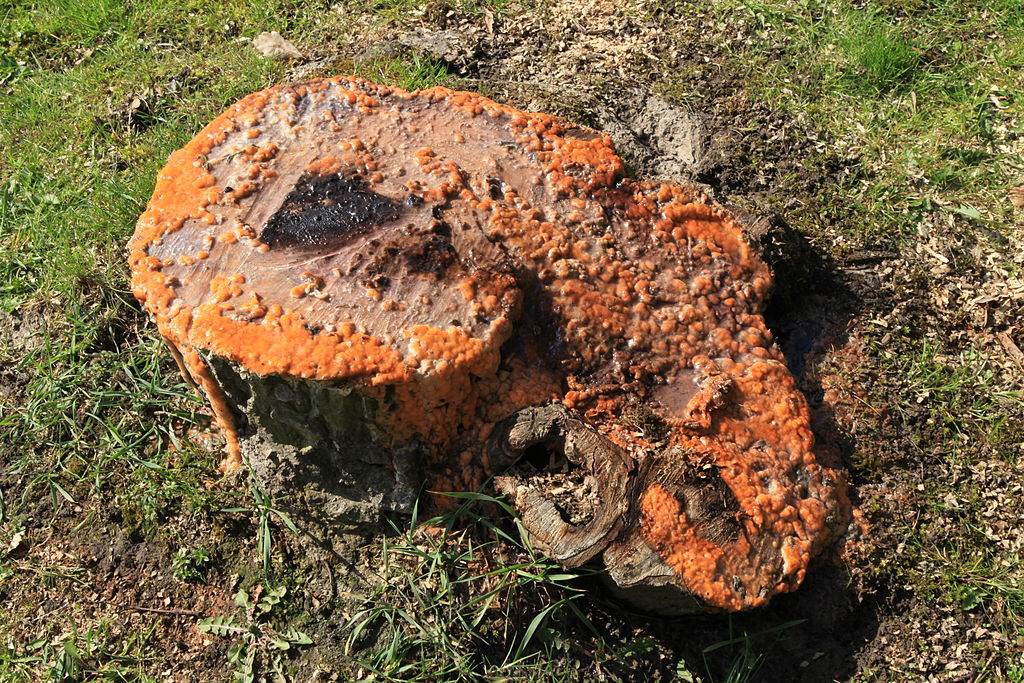Introduction
Bacterial wetwood, often referred to as slime flux, is a bole rot that afflicts hardwood trees. The disease is associated with numerous bacteria, which infect the inner sapwood, and outer heartwood. Bacterial infection generally occurs when a tree has been wounded, or is suffering from environmental stress. Once an infection has occurred, the bacteria feeds within the inner tissue, utilizing the sap as a nutritional resource. This causes slimy, water-soaked areas to appear in the trunk, branches, and roots of infected trees. Bacterial wetwood is not fatal to trees, but it is considered a chronic disease. Persistent infection can contribute to a general decline in tree vigor over time.
Hosts
The trees that are most susceptible to bacterial wetwood include elm, apple, crabapple, London plane, redbud, aspen, dogwood, magnolia, Russian olive, beech fir, maple, sweet gum, sour gum, birch, hemlock, mountain ash, sycamore, boxelder, hickory, mulberry, butternut, horse chestnut, oak, tulip tree, cottonwood, linden, pine, black locust, poplar, willow, and walnut.
Some bacteria target specific hosts. One example is Enterobactor cloacae, which is the causal agent of bacterial wetwood in elm. Species of Clostridium, Bacillus, Klebsiella, and Psedomonas have been identified as the causal agents in various other trees.
Disease Cycle
The disease cycle begins when bacteria infiltrate the sapwood. The bacteria reside in the sapwood, feeding on the sap. As the sap is consumed, the oxygen in the heartwood is depleted, and methane is produced. This causes the pH of the sap to increase. As the pH rises, the sap ferments, and a high pressure develops in the wood. The mounting pressure, which can reach up to 60 psi, forces bacterial ooze, or fermented sap, to seep out of any cracks or wounds. The ooze is alcohol based, and toxic to new wood. As it is exuded from the tree, the ooze kills the cambium near any wounds, preventing them from effectively callusing over. Any herbaceous plants or grass that the ooze drips onto are killed as well. As the ooze trickles down the trunk, it causes the bark to become discolored.
Symptoms
The first external symptom of bacterial wetwood is a seeping or bleeding from the wounded tissue in branch crotches, pruning cuts, injection holes, and cracks in the trunk. A slimy, foul liquid is discharged from the tree, and trails down the bark, causing visible staining. Insects are attracted to the liquid, upon which they feed. When affected by bacterial wetwood, the branches of younger trees often wilt. Mature trees may experience a reduction in foliage.
Bacterial wetwood can also be observed internally. If an infected tree is removed, the heartwood will appear darker in color than the surrounding wood. Water-soaked patches that range from dark brown to black will also be identifiable in the tree’s trunk and limbs.
Management
There is no effective remedy or preventative treatment for bacterial wetwood. The following methods may be used to help alleviate symptoms, and manage infections:
- When planting, select trees that are disease resistant. Plant trees in locations where there is little urban soil compaction.
- Fertilize stressed trees to stimulate growth and mitigate the severity of the disease. Refrain from over fertilizing healthy trees, as this may increase their susceptibility to the disease.
- Remove and dispose of any dead or weakened branches, as well as any loose or diseased bark. Disinfect tools with 70% rubbing alcohol prior to pruning, and apply clean cuts around the wound to facilitate healing.
- Avoid boring holes in trees. Boring will not enhance recovery. Instead, it will create additional wounds through which disease pathogens and insects can enter.
- Avoid using draining tubes to cleanse infected areas. Drainage tubes can inadvertently transmit the disease to other sections of the tree.
- Ensure that trees are sufficiently watered, especially during periods of dry weather.
- Apply a layer of organic mulch around the base of susceptible trees. This will help improve soil quality, retain soil moisture, and moderate soil temperature.
- Avoid inflicting any mechanical injuries on trees.
Additional Resources:
http://nac.unl.edu/documents/diseasetrees/chap29.pdf
Photo courtesy of Frank Vincentz, and available for reuse under the Creative Commons Atribution-Share Alike 3.0 Unported license.


